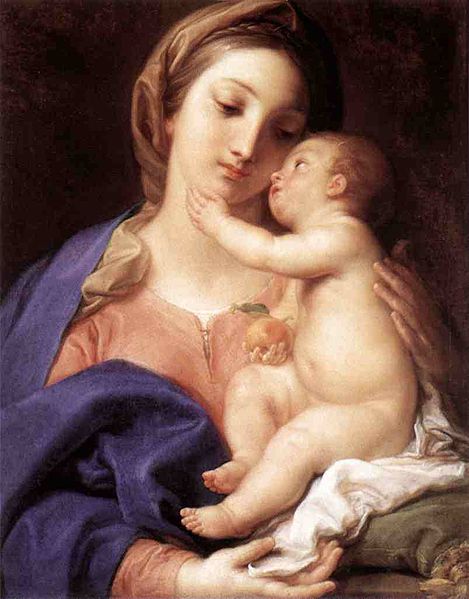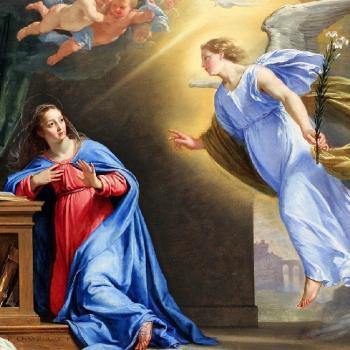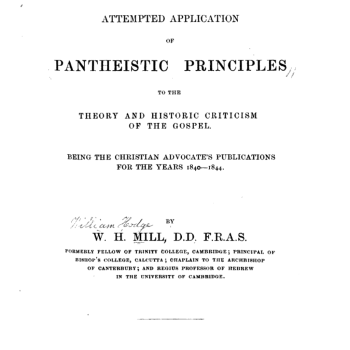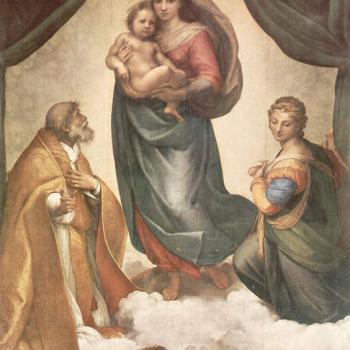
Madonna and Child (c. 1742), by Pompeo Batoni (1708-1787) [public domain / Wikimedia Commons]
***
[1-29-07]
**
The following is my response to a Catholic convert, Jonathan, who described himself as “struggling.” His words will be in blue.
***
As a recent convert to Catholicism I must admit that the most difficult and frightening thing for me to understand is the Catholic perception of Mary.
You’re not alone, believe me. Ironically, this wasn’t true in my case. My biggest beef by far was papal infallibility. But most of us who went through the conversion process struggled mightily with one or both of those issues, because they are perhaps the most radically different from the beliefs of most Protestants.
As a former 27 year Protestant the issue doesn’t just lie with the Protestant concern of idolatry as much as just wanting to know how to properly approach the issue without either excess or neglect.
That’s good. The idolatry thing is a big hurdle.
I have read a great deal on the church’s teachings and discussed her with other Catholics but I for some reason still have difficulty grasping the concept. I do think that it is largely a result of excesses that play out in my mind as well as what has been ingrained in me about her from anti-Catholics (having been one myself as well).
The effects of our past allegiances and belief-systems do not go away immediately. I notice in my own life (after 16 + years since my conversion) that this is the case, particularly with things such as the liturgical calendar. I find it difficult to “resonate” with that in the way a cradle Catholic would and does, because it formed no part of my background prior to conversion. To me all days were pretty much the same. The concept of Lent would have appeared to me as harmless, but silly and unnecessary. Now I know better, but it is still difficult sometimes to relate to the rhythmic, cyclical Catholic liturgical calendar. And that is simply because of past ingrained habit.
I must first say I have recognized the RCC as the New Testament Church and stand by the Church having been guided into all truth by the Holy Spirit. For this reason I do accept the Church’s teachings to her regard but nonetheless I do struggle with fully understanding them.
There is nothing wrong with that at all. That is precisely my task as an apologist: to help people to better understand and internalize why we believe what we believe.
I must first point out that my trouble does not lie in what is taught about her as far as the Immaculate Conception, the Assumption, etc. are concerned. My primary trouble is in the acts of veneration and prayer so I was hoping to ask you a few questions to this regard.
Sure. It’s my pleasure to be of any assistance that I can be to you (and by extension, others reading this who may relate to your struggles).
1) I was listening to the Journey Home program (EWTN) and (hoping I didn’t take it out of context but) one of Marcus’ guests had said something to the effect that the “Hail Mary” was the most important prayer one can pray. I understand that it is not necessarily about Mary but more in line with the life of Christ. However, in reviewing the prayer I find that when prayed Mary is most oft mentioned in its entirety. Granted it is largely due to the repetition of the prayer but still I find it difficult meditating on Christ when Mary is so prevalent in the prayer. If it is a meditation on Christ then why is Mary so heavily infused into the prayer?
One must understand the nature of the Rosary and the purpose of the repetition. Most of the words of the Hail Mary are, it should be noted, straight from the Bible. And it’s incorrect to say that because “Mary” may be the word repeated more than any other in the Rosary, that, therefore, she is considered more important than Jesus, or the focal point of the Rosary meditation. The intent of the repetitions of the Hail Mary prayer is to form a sort of “background music,” so to speak, to the meditations on (mostly) the life of Jesus.
It reminds me a bit of an analogy from my past as a trombone player in my high school band and orchestra. We had to play at graduations every year, the famous Pomp and Circumstance, by Edward Elgar. It was extremely repetitious. We’d play the thing over and over, until all the graduates had walked across the stage to receive their diploma. Almost needless to say (if you know me very well), I got pretty bored.
Now, was the purpose of the commencement ceremony to hear Pomp and Circumstance 741 times? No, of course not. It was to honor the graduates for their accomplishment in achieving a high school diploma. The music was the background, just as a soundtrack to a movie is. It’s not a perfect analogy (few are), but the Hail Marys in the Rosary are, at least in part, a sort of rhythmic background to the meditations. It’s a way (rather ingenious, when fully understood) to move forward in the prayer, and to avoid distraction (something we are all very familiar with when we try to pray).
We all learn to do more than one thing at a time in other areas of life. We can drive and listen to music or a talk show. We can mow the lawn and also keep an eye on our kids playing, and enjoy the blue sky and talk to our spouse (and chew gum!) all at the same time. The Rosary is another instance of doing two things at once.
You say it is difficult to meditate on Christ while repeating the Hail Marys. This is (like my difficulty in relating to the liturgical calendar), I would venture to guess, probably mostly a function of the unfamiliarity with the Rosary. It is initially very foreign to us former Protestants: especially an old “Jesus Freak” like I was: very unsacramental and informal in my former worship, and used to non-formal prayers (and I’m a very informal type of person, generally speaking).
It’s very different from much of Protestant piety, just as things like penance and purgatory and prayers for the dead or asking saints to pray for us are quite foreign at first to the typical evangelical Protestant mind, such as mine was (and, I take it, yours). It is a “learned art,” to a large extent. Your experience is common to many thousands of converts. Kimberly Hahn, for example, struggled with these concepts for years, but now she loves Catholic Marian devotion (as I do).
I think that, of all the things I deal with and discuss in the course of my apologetics, I love to write about the Blessed Virgin Mary the most, because it is such a beautiful, sublime part of Christian spirituality: full of profound depth and insight. Protestantism greatly impoverished itself when it minimized or eliminated, the full Catholic Mariology that remains intact in the Catholic Church. It was not always so. Martin Luther himself had a very high Mariology (including belief even in her Immaculate Conception). He wrote:
Our prayer should include the Mother of God . . . What the Hail Mary says is that all glory should be given to God, using these words: “Hail Mary, full of grace. The Lord is with thee; blessed art thou among women and blessed is the fruit of thy womb, Jesus Christ. Amen!” You see that these words are not concerned with prayer but purely with giving praise and honor . . . We can use the Hail Mary as a meditation in which we recite what grace God has given her. Second, we should add a wish that everyone may know and respect her . . . He who has no faith is advised to refrain from saying the Hail Mary. (Personal Prayer Book, 1522)
Lastly, we find in the Bible, a similar sort of repetitious, chant-like form. Take, for example, Psalm 136, where the same exact phrase (“for his steadfast love endures forever” – RSV) is repeated for 26 straight verses! The same technique is used in popular songs, where the chorus repeats itself, and causes the hearer to remember the song better. The Hail Marys in the Rosary are somewhat like that. At least that is one way I and many others have understood the purpose of the seemingly (at first) “excessive” repetition.
2) I understand the Church looks at Mary as an example by which we should live our lives in that when God calls we should follow in absolute faith and without question. Why is Mary so highlighted in this regard over a great many others who have done the same i.e. Abraham, Moses, etc.?
Because Mary is unique, being immaculate, the Mother of God, and the New Eve, and assumed bodily into heaven. She was the one creature chosen by God to “reverse” the effects of the Fall. This is the New Eve, or Second Eve concept; discussed by many of the Church fathers, such as St. Irenaeus: Eve said no, and rebelled against God; Mary said yes to the angel and to God at the Annunciation, and was willing to bear God the son, so as to make salvation possible to men. So she is the very highest creature. Martin Luther made a wonderful commentary on this:
She became the Mother of God, in which work so many and such great good things are bestowed on her as pass man’s understanding. For on this there follows all honor, all blessedness, and her unique place in the whole of mankind, among which she has no equal, namely, that she had a child by the Father in heaven, and such a Child . . . Hence men have crowded all her glory into a single word, calling her the Mother of God . . . None can say of her nor announce to her greater things, even though he had as many tongues as the earth possesses flowers and blades of grass: the sky, stars; and the sea, grains of sand. It needs to be pondered in the heart what it means to be the Mother of God. (Commentary on the Magnificat, 1521; in Luther’s Works, edited by Jaroslav Pelikan et al, vol. 21, 326)
Now she is the Queen of Heaven. I saw some interesting material recently (written by a young convert) that showed how, in the Old Testament, the Queen Mother was often mentioned. She had a high place of honor, right after the king. Jesus is now King, glorified in heaven, and Mary is His true mother. So she is the Queen of Heaven. It’s all very biblical, and Revelation 12 even makes this a fairly biblically-explicit Marian doctrine.
For an introduction to Catholic Marian piety, I recommend reading first (of all my papers on the topic), “The Imitation of Mary.”
3) When Pope John Paul II was shot in Turkey he cried out repetitively “Mary my mother…” but not once to my recollection did he call out to Christ.
The two amount to the same thing. There is no need to create a dichotomy. To ask Mary’s intercession is to pray to God, because Mary goes to God and intercedes on our behalf. This involves an explicitly biblical principle as well. The Bible says that “the prayer of a righteous man has great power in its effects” (James 5:16). The example given (5:17) was that of Elijah, who could stop or start the rain with his prayers.
Well, Catholics believe Mary is immaculate and sinless. Protestants agree with us that she is the Mother of God. This is an extraordinary person; very close to God: as close as any creature everwas or ever will be. We can and should (if we are wise) ask her to pray for us due to that proximity to God, because her prayers are more powerful than ours are. She can hear our prayers because she is (being in heaven) out of time and able to see happenings on the earth (see, for example, Hebrews 12:1).
Dead saints are far more alive than we are ourselves, and care about earthly happenings. In Revelation 6:9-10, dead saints are literally praying for those on the earth. In Revelation 8:3-4 (cf. 5:8), and angel is spoken of as having “the prayers of the saints”. What is he doing with human prayers, that supposedly can only go directly from men to God?! It is because we can ask an angel (a righteous, non-fallen creature) to pray for us, too. How much more, then, can we ask Mary to intercede?
Then after his wounds healed he credited Mary to his survival and made a pilgrimage to Our Lady of Guadalupe (I think that was the one) in honor of her.
Just as the person Peter raised from the dead would naturally have thanked him, without any implication that it was not God Who ultimately performed the healing. It’s a false dichotomy.
Once again I failed to hear anything about Christ’s intervention on the matter.
You actually did, once you fully understand Catholic Mariology, because to attribute to Mary any good thing always goes back to God: the one Who answered the prayer and Who created her immaculate in the first place. You’re making the same mistake that Protestants habitually make (which is understandable; I would submit that this is, again, the force of habit in you), saying that to mention Mary at all is to somehow detract or subtract from the glory of God. Catholics don’t look at it that way at all.
To us, all the glory goes to God, just as praising a great work of art is actually giving praise to the artist who created the work. Everyone knows this. If someone says, for example, that Michelangelo’s Pieta is “magnificent” or “inspired art” it is understood that he is praising Michelangelo. Likewise, when a Catholic honors and reveres Mary (not worship, that can only be applied to God!), he is, by that same act, honoring God far more. And when he attributes an answered prayer or miracle to her, it is understood (or should be), that it was God Who answered by her intercession, which is powerful because she was immaculate, which in turn goes back to God Who made her immaculate by a special miraculous grace.
If the glory belongs to God and Christ is our Mediator to Him then was this an appropriate devotional matter
Absolutely; per the above explanation.
or does it fall in line with my next question?
Surely.
3) I have often heard Catholics and non-Catholics alike say that Mary has special sway over Christ because she is His mother. Does this have to do with anything about why Catholics look to her so often or is this a misguided excess?
Yes (it’s not excess, if rightly-understood and practiced); I explained that above, too. Mary has a special, unique place in salvation history because of her role as the Immaculate Mother of God and Mediatrix, and now Queen of Heaven. More on her function as Mediatrix below, because you ask about it, too.
4) I read some quotes from the Catechism that if you at once accepted the Marian dogmas but then doubt the truth of them you are considered anathema. Does the RCC consider her beliefs about Mary and veneration to her as necessary for salvation?
In the sense that one must accept the whole of the Catholic faith, yes. That doesn’t mean that if someone doesn’t fully understand a doctrine, that they will be damned, period. It’s more a matter of consistency. The Catholic accepts the entire deposit of faith and Catholic dogma, because the Catholic antecedently accepts by faith and God’s grace the divinely-protected authority of the Catholic Church, to uniquely preserve the fullness of Christian truth in the first place. Therefore, it makes no sense to pick and choose. Once one accepts the Catholic principle of authority, they must accept the whole ball of wax.
Again, that doesn’t mean that every catholic will or must completely understand to the nth degree, every Catholic doctrine. But he must be willing to accept by faith that all Catholic doctrine is true. Then the apologist steps in and that point and can aid the Catholic believer in better understanding the biblical, historical, and intellectual rationale behind any particular belief (exactly what I’ve been dong in this paper).
5) Why is it necessary to believe the Dogmas? Example: The Assumption – How does it really hold any impact on ones faith? In the end, does it really matter whether she was or was not?
Absolutely. Mary was, one could say, the first Christian. She was the first to experience the full fruits of Jesus’ Resurrection, by which all saved persons will be resurrected one day. Thus, the Assumption is supremely important, because it illustrates the effect of Jesus’ Resurrection on all who are saved. It was altogether appropriate that Mary be immediately resurrected, rather than undergo decay, because she was an unfallen creature in the first place, and decay only comes as a result of the fall. Hence, she simply is what we all could have been. That’s why she was immaculate and was assumed into heaven. It all works together.
6) What is actually meant by Mediatrix and Co-redeemer?
Aside from the last question, these are things I have been pondering for quite some time now and haven’t really found sufficient answers for. The last one just sprang to mind so I threw it in there having not actually looked it up yet. I know these questions are quite involved and I’m sorry for so many. Any help understanding these would be greatly appreciated.
You’re welcome. No problem. I’m glad to be of any assistance. The issues of Mediatrix and Co-Redeemer are much misunderstood and complex and not given to short summary (though not as complicated as often supposed). Therefore, I strongly recommend that people read an introductory treatment, rather than jump to inaccurate conclusions as to what is meant (which is very common). [intro. papers: one / two]
Thanks for your questions. I look forward to interacting with you and others further, in the discussion below this post. God bless you. You have your whole life to better understand Catholic theology. You don’t have to grasp everything fully all at once. Who ever achieves a truly” full” understanding, anyway? We’re all constantly learning. That will never end. But we can all rest in the knowledge that there is such a thing as “the Church” — ordained by God to preserve theological truth, and protected by the Holy Spirit. We’re not on our own. We don’t have to reinvent the wheel in every generation, or on an individual basis. We can trust the truths that have been passed down to us. God sees to it that they are preserved intact.
*****
Meta Description: Replies to several inquiring questions about Mary from a recent convert to Catholicism, from Catholic apologist Dave Armstrong.
Meta Keywords: Blessed Virgin Mary, Mary, Mother of Jesus, Catholic Mariology, Rosary, Protestants & Mary, Marian excesses, Marian doctrines













